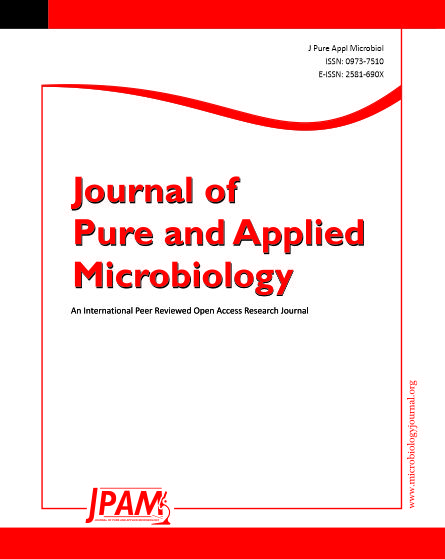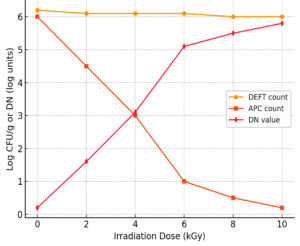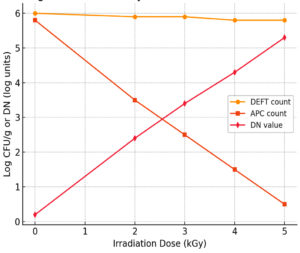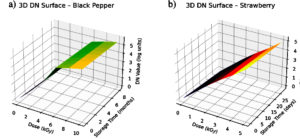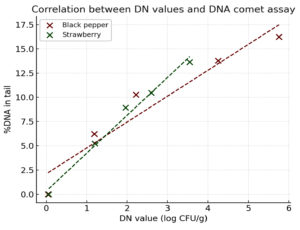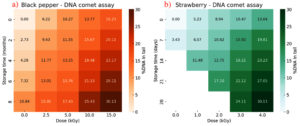ISSN: 0973-7510
E-ISSN: 2581-690X
Gamma-irradiation could be defined as an effective technique for microbial decontamination and shelf-life extension of multiple food products. The paper outlines the microbiological effects of gamma irradiation on an extensively broad divide of food items, namely perishable plant-based goods (strawberries) and antioxidant-rich spices (black pepper). Taking into consideration experimental data, we study the effects of irradiation on microbial load in terms of aerobic bacteria count, Gram-negative bacteria, Enterobacteriaceae, molds, and yeasts. Another aspect served by us is the application of microbial methods such as Direct Epifluorescent Filter Technique/Plate Count (DEFT/APC) ratios. By comparing two fundamentally different food matrices-low moisture spices and high moisture fruits-fresh insight is given into the food-type-and-storage-condition-dependent variation of gamma irradiation efficacy. The results show drastic changes in microbial flora after irradiation, with almost complete collapse of surviving microbial populations in both categories. The results demonstrate the efficiency of gamma irradiation as a decontamination method and validate the use of microbial indicators for assessing post-treatment food quality.
Gamma Irradiation, Microbial Load, Perishable Foods, Spices, DEFT/APC, DNA Comet Assay, Food Safety
Food safety assurance and shelf-life extension have become two key areas of emphasis in today’s food industry for purposes of global food security and public health. Gamma irradiation, a process of ionizing radiation, is now acceptable for the notable reduction of microbial contamination without strikingly affecting the nutritional content or sensory characteristics of food.1,2 With respect to various kinds of food, this process has become more or less effective in targeting spoilage and pathogenic organisms.
In the present study, we consider the two opposite classes of food: a perishable, fresh fruit like strawberries, and a dry spice enriched with antioxidants like black pepper in order to understand the response of irradiation on different food matrices, especially those with contrasting moisture levels and antioxidant contents, in terms of microbial survivability.
Comet test quantification in recent research on irradiated biological systems has shown to be a sensitive way to identify oxidative lesions and breaks in DNA caused by gamma exposure, confirming its use as a quick indicator of irradiation effects in target tissues.3
At the cell level, gamma irradiation affects microorganisms via direct and indirect mechanisms. Direct effects target the DNA of microorganisms, inducing strand breaks and mutations that inhibit replication. Indirect effects consist of water radiolysis in food and reactive oxygen species generation (like hydroxyl radicals) that impose further damage on the structures of a microbial cell.4 These mechanisms act together for a reduction in microbial viability after irradiation.
For assessing and confirming the microbiological consequences of irradiation, sensitive and reliable detection methods are necessary. Two of the most useful techniques are the Direct Epifluorescent Filter Technique together with Aerobic Plate Count (DEFT/APC) and the DNA comet assay. The DEFT/APC measures total microbial count and compares it with the count of viable colony-forming units from irradiated and nonirradiated samples, while the comet assay measures DNA damage at the cellular level.5,6
This paper compiles and analyses data from microbiological studies carried out in the experiments that have employed these detection tools. It is intended to present a comparative view of the shift in microbial load after gamma irradiation in the two food systems. Specific attention is given to the reduction of key pathogens which include Gram-negatives and Enterobacteriaceae, factoring in the performances of the methods under varied irradiation and storage conditions.
Gamma irradiation indeed has been receiving immense attention on account of its microbial decontamination in different food groups. Bazaraa et al.⁷ demonstrated that DEFT/APC methods could differentiate irradiated from non-irradiated ones and hence the application of microbiological tools into food safety monitoring. Whereas previous studies have focused on microbial decontamination by irradiation in food classifications that include meat, seafood, and dry spices,8,9 little work has been done to assess food types with completely different moisture and antioxidant properties using microbial detection tools. This study fills that gap because it contrasts the microbial behaviours of perishable fruits and antioxidant-laden spices under irradiation, specifically strawberries and black pepper. This combination of foodstuffs enables a clearer view of matrix characteristics’ influence on microbial survival and detection sensitivity, thus aiding more directed decontamination avenues.
Review of literature
Gamma irradiation is one heralded method of food preservation, which is highly effective at eliminating a great deal of microbial contamination, yet does not compromise much on nutritional quality.1,2 In fact, the technology will employ ionizing radiation, normally gamma rays from cobalt-60, to destroy the DNA of microorganisms, so therefore replication would fail, and with this death, cells shall be induced.4 Therefore, this method suits decontaminating all high-moisture perishable foods in addition to low-moisture, contamination-sensitive spices.
Food irradiation and microbial reduction
The efficiency of gamma irradiation in microbial inactivation varies with food matrix characteristics such as moisture content, antioxidant levels, and initial microorganism load. Fresh produce is frequently contaminated is contaminated with high concentrations of aerobic mesophilic bacteria, spore-formers, molds, and yeasts; such dirty handling of the crop after harvest.10 Strawberries are very sensitive fruits that spoil almost immediately with microbial proliferation at their very high sugar content and soft textural composition, making them conducive to fungal and Gram-negative bacteria attack.11
Microbial detection of irradiated foods
Historically, the traditional approaches of detection with respect to irradiation have centered greatly around physical and chemical techniques such as electron spin resonance and measuring radiolytic compounds.9 Yet, this technique proves to be costlier and would require sophisticated setup. In contrast, microbiological techniques are relatively easy, cheaper, and reliable enough for screening.
Gamma irradiation’s effects on the microbiological purity, sensory qualities, and shelf life of beef and poultry products-both immediately following treatment and during storage have also been thoroughly examined, underscoring its wide range of applications in a variety of food matrices.11
Among the microbial techniques, rising as the validated screening methodology (EN 13783:2001) is the combination of the Direct Epifluorescent Filter Technique with Aerobic Plate Count (DEFT/APC) method. DEFT counts total microbial cells, both living and dead, through use of fluorescent staining, while APC reflects just the viable CFUs that can grow. The difference between numeration (DN) hence stands as a true indicator of previous irradiation.12
Irradiation has been demonstrated to dramatically reduce microbial growth and preserve desired physicochemical and flavour characteristics in ready-to-eat items like chicken sausages under refrigeration, hence bolstering the product’s dual safety and quality advantages.13
Studies have shown that DEFT counts remain rather constant in irradiated samples due to the persistence of non-viable cells, while APC drops dramatically, leading to a high DN value. This has successfully been applied to a wide range of food products, including dried spices and herbs, fruits, and meats.13
Dose-dependent microbial responses
Microbial response to gamma radiation is dose dependent. Most Gram-negative bacteria and vegetative cells show greater sensitivity, while spore-forming bacteria and fungi spores are more resistant. Effective microbial control of strawberries has been achieved at doses of 3-5 kGy, while for black pepper decontamination towards more than 10 kGy may be required.14 The storage conditions also affect the extent of microbial reduction since sub-lethal doses may allow the organism to regrow in favorable post-irradiation environments.
Such observations warrant the need for tailor-made irradiation protocols, plus DEFT/APC as an important validating tool in post-treatment studies.
In their study conducted in 2013, Ibrahim et al. used DEFT/APC as a suitable screening method for the detection of gamma-irradiated foods, including plant- and animal-based products. Their findings confirmed notable changes in the microbial profile after irradiation, especially in poultry products, indicating that the method is versatile across different food matrices.6
Recent studies highlighted the versatility of gamma irradiation in decontaminating different food items. According to Fan and Sokorai15 treating spices, particularly black pepper, with doses of up to 10 kGy minimizes their microbial loads without inflicting sensory changes. Balakrishnan et al.16 further confirmed that irradiation processes break microbial DNA, rendering spice samples unable to grow. On spoilable foods, Danyo et al.17 observed that gamma-manipulated fresh-cut fruits and vegetables had a dramatic microbial decline, and the quality was not compromised. Rahman et al.14 observed that microbial control in spices was microbial control was sustained during storage. A study presented a general review indicating the broad-spectrum applicability of gamma irradiation throughout food matrices-from high-moist perishable products to low-moist spices.
The importance of combining molecular DNA damage assays with microbial enumeration to identify food irradiation has been highlighted by recent investigations. In order to compare microbiological quality with oxidative and structural changes caused by UV-C,
Researchers18-22 used multi-parametric techniques. Likewise, it has been proposed that the combined use of DEFT/APC ratios and comet assay parameters can enhance the ability to distinguish between foods that have been exposed to radiation and those that have not, particularly in cases when storage time partially obscures the effects of radiation. Although statistical correlations between molecular and microbiological markers have been suggested as a possible way to estimate dose and verify irradiation history, these integrated analyses have not been frequently used to examine both high- and low-moisture foods in the same study.
Advanced irradiation modalities have also been shown to improve comet assay detection sensitivity, indicating a wide range of ionising radiation types that are pertinent to food and therapeutic settings.
The comet assay’s durability at low-dose thresholds is further supported by comparable sensitivity in detecting sublethal irradiation doses in unrelated biological systems.
Research objectives
- To determine how microbial load is affected by gamma irradiation in black pepper and strawberries using DEFT and APC count and also to evaluate DN values as a differentiating tool between irradiated and non-irradiated sample.
- To incorporate DNA comet assay as a molecular marker of irradiation-induced DNA fragmentation.
- To perform Statistical correlation analysis between comet assay parameters and DN values.
- Compare microbial and molecular response between high moisture and low moisture matrices.
Sample selection
Two food products were purposely selected to represent different categories of microbial risk and physicochemical characteristics: (1) Black Pepper (low moisture, high microbial burden). (2) Strawberries (high moisture, high perishability).
Samples were purchased from local markets and divided into portions for gamma irradiation by Indian Co-60 Gamma Research Irradiator at different doses for black pepper and strawberry between 0-10 kGy.
Irradiation process
Indian Co-60 Gamma Research irradiator was used for Irradiation. The samples were kept inside polyethylene bags and exposed to gamma radiation in room temperature. Doses were adjusted to those used in industrial practices focusing on microbial decontamination.
DEFT/APC for detection of irradiated foods
This research employed Direct Epifluorescent Filter Technique/Aerobic Plate Count (DEFT/APC) for microbiological consequence assessment caused by gamma irradiation. This dual procedure has been validated as a reliable microbial indicator by European Committee for Standardization EN 13783:2001 meant for screening irradiated food products.8 The method DEFT/APC takes advantage of the disparity between total microbial cells (both viable and non-viable) observed microscopically and only the viable colony-forming units (CFUs) grown on culture media. Irradiation kills microbes but leaves cell structures detectable by DEFT so DEFT counts exceeded APC counts in irradiated samples.
DNA comet assay
Quantification and control storage
Except for the irradiation step, unirradiated control samples (0.0 kGy) were treated exactly like irradiated samples. In addition to irradiated samples, black pepper controls were kept at room temperature for up to eight months, and strawberry controls were kept at 4 ± 1 °C for up to twenty-eight days.
All treatments used the same exposure settings to acquire comet photos at 400× magnification. Three slides were made for each condition, and OpenComet (an ImageJ plugin) was used to analyse at least 100 nuclei. The software computed the Olive tail moment, tail length (µm), and the percentage of DNA in the tail. Pre-established filters were used to weed out comets with saturated fluorescence or unusual “hedgehog” form. A scorer who was blinded conducted the analyses.
Correlation analysis
The log difference between DEFT and APC counts was used to compute DN values. For both strawberry and black pepper, Pearson’s correlation coefficients (r) between DN values and each comet assay parameter were calculated independently. The threshold for statistical significance was p <0.05.
Comparative analysis by matrix type
For every food type, dose-response curves and trends in storage stability were examined in order to compare high- and low-moisture matrices. A two-way ANOVA was used to investigate for interaction effects (matrix × dose × storage).
Post-irradiation stability mapping
The persistence of irradiation signatures over time was visualized by creating heatmaps of DN and % DNA in the tail for every combination of dosage and storage.
Comparative microbial analysis: Black Pepper vs. Strawberry
Microbial load in Black Pepper
Black pepper is known to harbor many dense microbial communities, as it undergoes exposure during drying, handling, and storage. In untreated control samples, DEFT and APC counts were fairly close, while DN values were low, thereby indicating dominance by viable microorganisms. However, the higher doses of 6-10 kGy gamma-ray irradiation revealed a sudden difference in DEFT and APC counts.
At 8 kGy, the DEFT count remained high, indicating the presence of dead cells, while the APC almost approached zero, giving rise to a very high DN value. This confirmed effective destruction of viable microorganisms while retaining structural remnants seen under fluorescence microscopy. This trend was also observed with prolonged storage at room temperature, suggesting long-term microbial stability of the irradiated spice. Table summarizes the dominant microflora, effective irradiation dose, and post-treatment stability observed in black pepper and strawberries.
Table:
Comparison of microbial response to gamma irradiation in black pepper and strawberries
Parameter |
Black Pepper |
Strawberry |
|---|---|---|
Dominant Microflora |
Spore-forming bacteria, fungi |
Yeasts, molds, Gram-negative |
Effective Dose for Inactivation |
6-10 kGy |
3-5 kGy |
Post-Irradiation DN Value |
High (up to 3 log units) |
Moderate to high (1-2.5 log units) |
Storage Impact |
Minimal microbial regrowth |
Regrowth at low doses |
Detection Reliability (DEFT/APC) |
Excellent |
Good with higher doses |
The data provide strong evidence in support of DEFT/APC as a practical indicator of irradiated black pepper. All post-irradiation stages consistently showed high DN values (mostly >2 log units) that distinctly separated the irradiated from the non-irradiated samples.6
Microbial load in Strawberries
The large moisture content and sugar content of strawberries favor rapid microbial growth, especially molds, yeasts, and Gram-negative bacteria. In non-irradiated samples, microbial spoilage progressed rapidly during the course of refrigerated storage as treated by both DEFT and APC counts.
With irradiation at 3-5 kGy, there was a significant decrease in viable counts. Post-irradiation, DEFT counts showed very little decline, indicating the presence of damaged but fluorescent cells, together with a significant suppression of APC counts. The DN value was seen to rise proportionally with the increase in irradiation doses.
Intriguingly, on the contrary to what was observed in black pepper, reassertion of microbes in strawberries over time occurred more especially at sub-lethal doses (2-3 kGy) showing partial inactivation. On the contrary, at 5 kGy, the levels of APC throughout storage were near zero, yielding stable and high DN values as evidence of effective microbial suppression.
DEFT/APC comparison across food types
While both foods showed microbial decontamination following gamma irradiation, the extent and persistence of microbial suppression differed:
These comparisons highlight the efficiency of DEFT/APC in differentiating irradiated from non-irradiated foods, while also emphasizing the need for dose optimization based on food type and storage conditions.
Microbiological assessment: DEFT/APC
Microbial analysis has been performed using Direct Epifluorescent Filter Technique combined with Aerobic Plate Count, according to EN 13783 (2001) protocols:
DEFT count
Ten grams of sample homogenized in sterile diluent was filtered through 0.6 µm polycarbonate membrane, stained with acridine by orange, and examined under a fluorescent microscope. The results were given as cells per gram.
APC count
Parallel samples were serially diluted and plated on nutrient agar, incubated at 35 ± 1 °C for 48 hours, and counted as CFU/g.
Difference of Numeration (DN)
Calculated as log (DEFT)-log (APC). A DN value ≥2.0 log units was considered indicative of irradiation.
Samples were analyzed immediately after irradiation and thereafter during the storage period (8 months for black pepper at ambient conditions; 28 days for strawberries at 4 ± 1 °C).
DEFT/APC in Black Pepper
Both DEFT and APC values counted in untreated black pepper showed a positive high number, indicating the presence of a large viable microbial population. There was a relatively high decrease in APC with increasing irradiation doses while DEFT counts were fairly constant. This demonstrates the principle of the method: irradiation will inactivate a viable microorganism but never eliminates the cellular structures, which will still fluoresce under DEFT. As illustrated in Figure 1, DEFT and APC counts in black pepper show a significant divergence at higher irradiation doses, confirming effective microbial inactivation.
Between 6-10 kGy, there was significant reduction in APC counts (almost none at very high doses) such that the DN values were greater than 2.0 log units-a clear indication of irradiation. The microbiological profile though showed no change over a period of 8 months kept under ambient storage, thus confirming that irradiated black pepper has long-term microbial stability.
DEFT/APC in Strawberry
Strawberry samples not being irradiated got rapidly spoiled under cold storage, and DEFT and APC values increased with time. Gamma irradiation of 3-5 kGy helped decrease the APC values significantly while keeping the DEFT relatively constant, thus yielding moderate DN values of 1.5 to 2.8 log units. Figure 2 demonstrates the microbial response in strawberries, showing that while APC drops significantly with irradiation, DN values vary due to potential microbial regrowth at lower doses.
Samples irradiated with ≤3 kGy showed microbial regrowth at the end of refrigerated storage while this was not the case for those treated with doses ≥5 kGy. Only doses ≥5 kGy were sufficient to maintain microbial suppression throughout the 28-day period.
Figure 1 shows DEFT and APC counts, and DN values for black pepper across different gamma irradiation doses. A significant drop in APC and high DN values indicate effective microbial inactivation.
Figure 2 illustrates the microbial response in strawberries to varying irradiation doses. While APC drops significantly, DN values show more variation due to potential regrowth at lower doses.
Interpretation of DN values
The DN values were consistently able to differentiate irradiated samples from non-irradiated ones. For instance, with black pepper, DN values remained high despite prolonged storage; however, in strawberries, the values were more variable with respect to the dose and storage time. These differences thus point to the fact that higher irradiation doses or shorter storage times are needed to control microbes in moisture-rich perishable products. This also shows that lower water activity may slow degradation of irradiation signatures.
Comet assay sensitivity & stability
Both strawberry and black pepper showed DNA fragmentation at all irradiation dosages, according to the comet assay. Although the rate of change varied by matrix type, the percentage of DNA in the tail and tail length rose considerably (p <0.05) with dosage at time 0 and remained elevated throughout storage as seen in Figure 3.
Figure 3. 3D surface plots: DN value as a function of dose × storage time. (a) Black pepper (8 months), (b) Strawberry (28 days).
Correlation analysis
There was a significant correlation between DN values and the percentage of DNA in the tail (black pepper r = 0.92; strawberry r = 0.95) and tail length (black pepper r = 0.89; strawberry r = 0.94), all of which were p <0.001. These associations validate the complementing evidence of irradiation provided by molecular and microbiological endpoints as also seen in Figure 4.
Figure 4. Shows the correlation between DN values and % DNA in tail at time 0 for both black pepper and strawberry
Post irradiation stability
In strawberry, DN values started to converge with controls after 21 days, but comet parameters remained elevated. In black pepper, irradiation markers remained above detection thresholds for the entire 8-month storage period, according to heatmaps of DN and % DNA in tail across dose X storage time as seen in Figure 5.
It is important to note that Figures 1-3 illustrate microbial dose–response patterns obtained at dose ranges optimized separately for strawberries and black pepper, while Figure 5 depicts trends of DN values across dose × storage interactions. Thus, the ranges presented are not identical, as they reflect the different analytical objectives: direct dose-response versus long-term stability mapping.
Results show that gamma irradiation has a quite significant impact on the microbial load of food matrices, either low or high in moisture content. The DEFT/APC technology, as applied on black pepper and strawberries, can effectively identify inactivation of microorganisms due to irradiation; thus, it offers a practical and validated tool for regulatory and quality control applications. This work is one of the few that combines DNA comet assay characteristics with DEFT/APC bacteria enumeration in both high- and low-moisture food matrices, allowing for a two-level evaluation of irradiation impacts. The DEFT/APC approach is validated at the molecular level by the correlation study between DN values and comet assay endpoints, demonstrating its dependability for long-term post-irradiation identification. A visual framework for forecasting microbial stability and DNA damage persistence is also provided via dose storage mapping using heatmaps.
Matrix-dependent irradiation sensitivity
That is no proof that black pepper, which supports many heat- or radiation-resistant spore-forming microbes, did not respond positively to gamma doses ≥6 kGy. The longevity of DEFT counts and decline of viable APC counts for 8 months testify to the long-term efficiency of irradiation for dried spices. In contrast, strawberries would require lesser doses (3-5 kGy) in suppressing microbes, but showed a potential for regrowth during storage environment at sub-lethal doses, chief because of its very high water activity and also nutrients left, giving good conditions for surviving microorganisms.
The differences between black pepper and strawberry reactivity to irradiation are a reflection of property differences in the food matrix. Black pepper has low water activity and is very densely structured, thus promoting microbial stability even during long-term storage, with high DN values indicating that inactivation is still sustained. Strawberries, however, were shown to reduce considerably viable counts at moderate doses but were prone to regrow in storage, particularly below optimum doses. These findings corroborate existing findings that high moisture promotes post-treatment microbial recovery.10
The comet assay profiles described in oxidative stress-driven cellular systems match the oxidative damage patterns we saw, demonstrating the assay’s mechanistic alignment.23
By simultaneously evaluating microbial enumeration (DEFT/APC) and molecular DNA damage (comet assay) across divergent food matrices, this study bridges methodological and mechanistic perspectives, offering a comprehensive diagnostic framework for post-irradiation verification.
Regulatory and industrial implications
Using DN values as screening tools fits into European standards for microbial detection of irradiated foods. DEFT/APC is non-destructive, fairly fast, and applicable across a wide range of food types, thus being particularly useful for customs inspections, export certification, and quality assurance in irradiation facilities.
This persistence is consistent with findings in medical diagnostics, where the comet assay has identified progressive DNA changes in the setting of chronic diseases, highlighting the technique’s capacity to monitor accumulated damage over time.24
Conceptually, ecological stabilisation experiments, in which controlled stressors move microbial equilibrium towards a known plateau, are comparable to this type of dose-storage response mapping.25
Moreover, data reiterated the aspects of optimizing irradiation doses in accordance to the type and expected shelf-life of foods. Over-irradiation might tamper with organoleptic properties, especially for fresh produce, while under-irradiation predisposes to incomplete control of microorganisms.
Irradiation-induced biochemical alterations have been documented in cocoa beans, where phenolic content and fatty acid profiles showed dose-dependent changes without appreciable nutrient loss, which is comparable to our findings in pepper and strawberries.26
The research shows gamma irradiation emerging as a potent microbial decontamination treatment for dry spices and fresh produce, as illustrated by the samples of black pepper and strawberries. The DEFT/APC technique applied demonstrated a clear reduction in viability of microbial populations post-irradiation with doses of greater significance intervening most effectively.
In comparison to strawberries, black pepper with low moisture content and stable microbial load sustained microbial inhibition over a longer period at ambient storage when irradiated at 6-10 kGy. In the case of strawberries, doses of 3-5 kGy of irradiation could reduce the microbial load during cold storage, whereas the lower doses allowed some regrowth.
The DEFT/APC technique is a well-established and reliable microbial screening method for irradiated foods. Simplicity, rapidity, and high sensitivity make it particularly advantageous for use in regulation. The distinguished DN values offer the microbiological signature for differentiating significantly between irradiated and unirradiated samples, thus being reliable for validation post-irradiation.
Collectively, our results validate the importance of including comet test quantification into post-irradiation food authentication procedures.
Similar to prior dose-response modelling in fresh produce, where predictive equations were created to estimate dosage levels using % DNA in tail data, our work found a good link between comet assay parameters and irradiation dose.
Through the combination of molecular damage assessment (DNA comet test) and classical microbiological enumeration (DEFT/APC), this work develops a reliable, multi-tiered detection technique for irradiated foods. These methods are complimentary, as evidenced by the high positive correlations found between DN values and comet assay parameters. A new development in irradiation detection methodology, the visual dose-storage models produced for foods with and without high and low moisture content offer useful information for shelf-life prediction and regulatory monitoring.
Future prospects for this study should include other potential applications, namely, incorporation with rapid digital image analysis, following expansion to other food commodities, and further validation in the different international irradiation facilities. On the whole, gamma irradiation with microbial analytical techniques like DEFT/APC seems to be a very promising approach for food safety and global trade facilitation.
ACKNOWLEDGMENTS
None.
CONFLICT OF INTEREST
The authors declare that there is no conflict of interest.
AUTHORS’ CONTRIBUTION
HKS conceptualized the study, applied methodology and performed investigation. KJ performed supervision and validation. HKS and KJ wrote, reviewed and edited the manuscript. Both authors read and approved the final manuscript for publication.
FUNDING
None.
DATA AVAILABILITY
The datasets generated and/or analysed during the current study are available from the corresponding author on reasonable request.
ETHICS STATEMENT
This article does not contain any studies on human participants or animals performed by any of the authors.
- Diehl JF. Food irradiation-past, present and future. Radiat Phys Chem. 2002;63(3-6):211-215.
Crossref - Thompson JE, Blatchley ER III. Gamma Irradiation for Inactivation of C. parvum, E. coli, and Coliphage MS-2. Journal of Environmental Engineering (ASCE). 2000;126(8):761-768.
Crossref - Afify A, Ali HM, Sayed RM. Estimating the impact of gamma radiation on biochemical aspects and DNA damage by comet assay in Galleria mellonella. Entomol News. 2024;131(1):30-42.
Crossref - Verbeek F, Koppen G, Schaeken B, Verschaeve L. Automated detection of irradiated food with the comet assay. Radiat Prot Dosimetry. 2008;128(4):421-426.
Crossref - Khawar A, Bhatti IA, Khan QM, Khan AI, Asi MR, Ali T. Evaluation of irradiation in foods using DNA comet assay. J Food Sci Technol. 2011;48(1):106-9.
Crossref - Osman ME, Abo El-Naser A, Abo El-Naser SA, Hammad A, Ibrahim HMA. Microbiological method (DEFT/APC) for the detection of irradiated foods in Egypt. Isotope Radiat Res. 2013;45(3):531-544.
- Bazaraa WA, El-Magoli SB, Hammad AA, Abdel-Khalek HH. Effect of γ-irradiation on the microbial quality and the biological activity of mixed spices powder. New Egypt J Microbiol. 2007;17(1):191-213.
Crossref - Farkas J. Irradiation for better foods. Trends Food Sci Technol. 2006;17(4):148-152.
Crossref - Delincée H. Analytical methods to identify irradiated food: a review. Radiat Phys Chem. 2002;63(3-6):455-458.
Crossref - Singh A, Singh D, Singh R. Shelf life extension of tomatoes by gamma radiation. Radiat Sci Technol. 2016;2(2):17-24.
Crossref - Hashim MS, Yusop SM, Rahman IA. The impact of gamma irradiation on the quality of meat and poultry: A review on its immediate and storage effects. Appl Food Res. 2025;4(2):100444.
Crossref - Rahman M, Islam MA, Das KC, Salimullah M, Mollah MZI, Khan RA. Effect of gamma radiation on microbial load, physicochemical and sensory characteristics of common spices for storage. J Food Sci Technol. 2021;58(9):3579-3588.
Crossref - You Y, Huang X, Xiao S, et al. Effect of gamma irradiation on microbial growth, physicochemical properties, and non-volatile flavour of chicken sausages during storage. Int J Food Sci Technol. 2024;59(3):1789-1800.
Crossref - Rahman M, Islam MA, Das KC, Salimullah M, Mollah MZI, Khan RA. Effect of gamma radiation on microbial load, physico‑chemical and sensory characteristics of common spices for storage.
J Food Sci Technol. 2021;58(9):3579-3588.
Crossref - Fan X, Sokorai KJB. Effect of ionizing radiation on microbial safety and quality of fresh-cut fruits and vegetables. Radiat Phys Chem. 2018;144:85-90.
Crossref - Balakrishnan N, Yusop SM, Rahman IA, Dauqan E, Abdullah A. Effect of gamma radiation and storage time on the microbial and physicochemical properties of dried Byadgi chili (Capsicum annuum). Agriculture. 2022;12(5):639.
Crossref - Danyo EK, Ivantsova MN, Selezneva IS. Ionizing radiation effects on microorganisms and its applications in the food industry. Foods Raw Mater. 2024;12(1):1-12.
Crossref - Chauhan SK, Kumar R, Nadanasabapathy S, Bawa AS. Detection methods for irradiated foods. Compr Rev Food Sci Food Saf. 2009;8(1):4-16.
Crossref - Gokmen S, Kocaba A, Savran Y, Sayaslan A, Aydyn MF, Yetim H. Effect of infrared, ultraviolet-C radiations and vacuum drying on certain chemical and microbial characteristics of stuffed pasta (Manti). J Agric Sci. 2019;25(1):100-107.
Crossref - Gokmen S, Caglar A. The effect on sensory quality of the stuffed pasta (Manti) of increased malondialdehyde amount with the UV-C radiation and storage. J Food Process Preserv. 2021;30(9):10586-10591.
- Cooper CR, Jones DJL, Jones GDD, Petersson K. Comet assay profiling of FLASH-induced damage: mechanistic insights into the effects of FLASH irradiation. Int J Mol Sci. 2023;24(8):7195.
Crossref - Dirven Y, Eide DM, Henriksson EW, et al. Assessing testicular germ cell DNA damage in the comet assay; introduction of a proof-of-concept. Environ Mol Mutagen. 2023;64(2):88-104.
Crossref - Tung GK, Gandhi G. Baseline and oxidatively damaged DNA in end-stage renal disease patients on varied hemodialysis regimens: a comet assay assessment. Mol Cell Biochem. 2023;479(2):199-211.
Crossref - Saied EN, Elmazny GM, El-Helaly RM, et al. Utility of comet assay of DNA damage in the detection of malignant transformation of chronic liver cirrhosis. Scand J Clin Lab Invest. 2023;83(3):145-151.
Crossref - King WL, Richards SC, Kaminsky LM, et al. Leveraging microbiome rediversification for the ecological rescue of soil function. Environ Microbiome. 2023;18(1):7.
Crossref - Apaydyn F. Effect of gamma irradiation on the nutritional composition, phenolic compounds and fatty acids profiles in raw cocoa (Theobroma cacao L.) beans. Food Measure. 2024;18(7):5297-5305.
Crossref
© The Author(s) 2025. Open Access. This article is distributed under the terms of the Creative Commons Attribution 4.0 International License which permits unrestricted use, sharing, distribution, and reproduction in any medium, provided you give appropriate credit to the original author(s) and the source, provide a link to the Creative Commons license, and indicate if changes were made.


